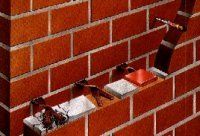Wall Ties
Damp Proofing London South Wall Ties

What a wall tie is and how it can fail
Wall tie failure is the corrosion of the protective coating of the wall tie and not as most people assume the actual breaking of the tie.
Why change your wall ties?
The metal wall ties rust over a period of time, this rusting will cause the tie to expand up to 7 times the original thickness, assuming a tie is approximately 4mm when new it could expand up to 28mm.
The pressure caused by the ties expanding causes horizontal cracking, as seen in the picture (left) above, bulging of the damaged walls and in extreme cases the collapse of damaged walls.
Best time to change wall ties
Wall Ties should be replaced between stages 2 and 3 of the above picture, this will ensure that the rusted tie cannot cause structural problems and involve the property owner with the expense of rebuilding.
The property in the picture above had to have sections of walling rebuilt as structural damage had occurred.
Damp Proofing London South Wall ties treatment
- New ties are installed by drilling through the outer leaf 65mm into the inner leaf of wall.
- A new tie which works by expanding to grip the outer and inner sections is installed
- The existing ties are then located using an electronic wall tie locator, metal detector.
- The mortar around the tie in the outer wall is then removed and the tie is then isolated, isolation can take on many forms.
- Like coloured mortars are used to fill in holes made for installation and isolation.
Isolation of the existing ties is very important, if the ties are not treated further damage will occur at a later date.
Need to change wall ties? Call Damp Proofing London South now.


